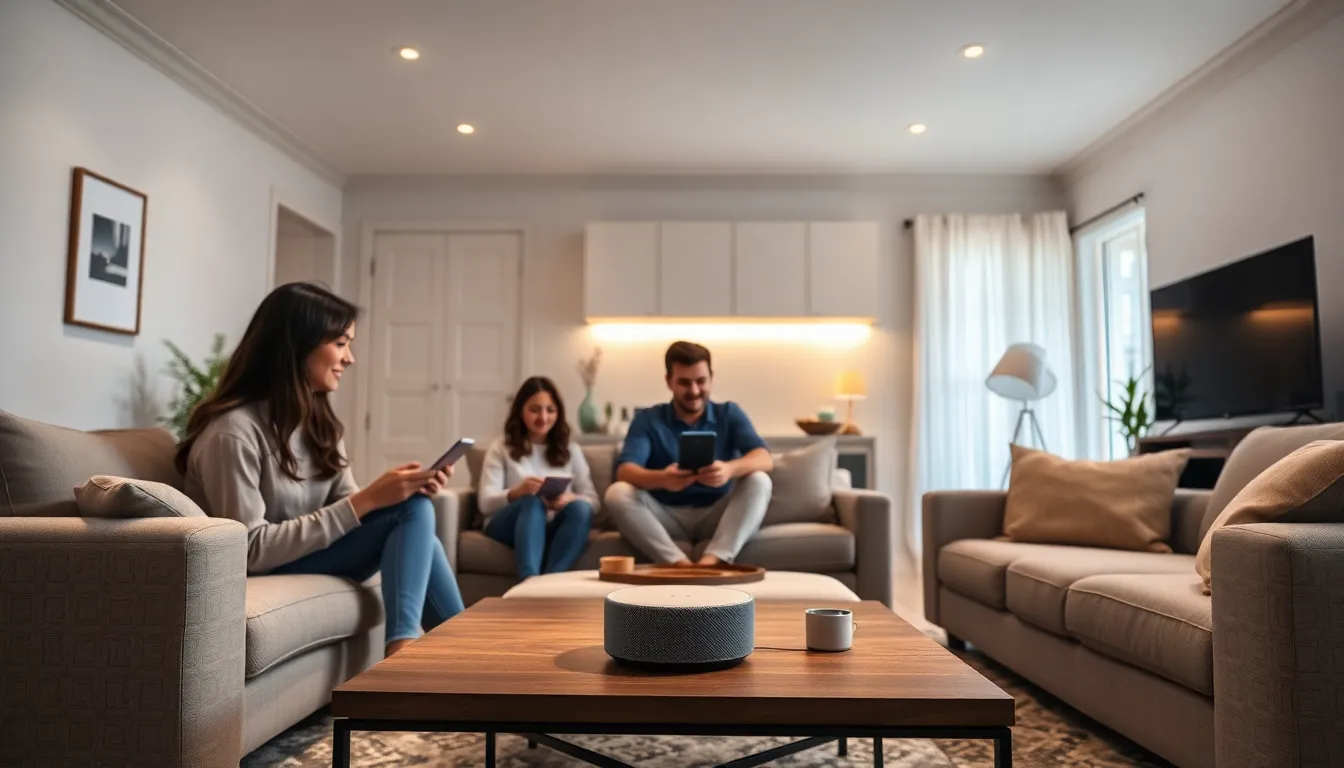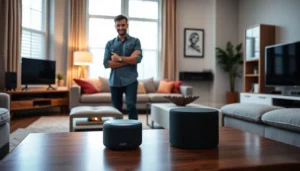Table of Contents
ToggleImagine walking into your home and having it respond to your every command—no more fumbling for light switches or searching for the remote. With voice-controlled technology, that dream is now a reality. It’s like having your own personal assistant, minus the awkward small talk and coffee runs.
Voice-controlled homes are revolutionizing the way people interact with their living spaces. From adjusting the thermostat to playing your favorite tunes, it’s all just a shout away. This tech-savvy approach not only adds convenience but also brings a touch of futuristic flair to everyday life. So why not let your home do the heavy lifting while you kick back and enjoy the perks of modern living? Get ready to explore how voice control can transform any ordinary house into a smart sanctuary.
Overview of Voice Controlled Home Technology
Voice-controlled technology transforms homes by enabling seamless interaction with various devices. Homeowners can manage their environments effortlessly through simple voice commands.
What Is a Voice Controlled Home?
A voice-controlled home relies on smart devices responsive to vocal instructions. Users issue commands to smart assistants, which connect to lights, thermostats, appliances, and security systems. Integration of artificial intelligence allows devices to learn preferences, creating personalized experiences. Reliable networks support these interactions, ensuring devices respond promptly. Popular systems include Amazon Alexa, Google Assistant, and Apple HomeKit, which provide a range of functionalities.
Key Features of Voice Controlled Homes
Voice-controlled homes boast several key features that enhance usability. Users can adjust lighting, temperature, and media playback without physical interaction. Smart security options allow for monitoring and controlling entry points via voice commands. Compatibility with multiple devices ensures a unified experience across brands, fostering convenience. Moreover, routine automation simplifies daily tasks, such as turning off lights or starting coffee makers. Advanced voice recognition improves accuracy and responsiveness, catering to diverse household members.
Benefits of Voice Controlled Homes


Voice-controlled homes provide numerous advantages that enhance daily living experiences. Smart technology opens the door to greater convenience and energy efficiency.
Convenience and Accessibility
Convenience stands out as a primary benefit of voice-controlled homes. Homeowners can perform many tasks hands-free, from turning on lights to adjusting the thermostat. Accessibility increases significantly for individuals with mobility challenges, as voice commands eliminate the need for physical interaction with devices. Guests can easily connect to systems, ensuring inclusivity and ease of use. Multitasking becomes effortless, allowing users to control their environments while engaging in other activities. Smart speakers integrate with numerous platforms, promoting streamlined access to a wide array of services. Voice-activated systems create a user-friendly atmosphere that makes life simpler and more manageable.
Energy Efficiency and Cost Savings
Energy efficiency also plays a crucial role in the advantages of voice-controlled homes. Smart devices enable users to monitor and adjust energy consumption with simple commands. Automated controls allow homeowners to set schedules for lighting and temperature, optimizing energy usage when rooms are unoccupied. Systems like smart thermostats can learn preferences and adapt settings automatically, leading to potential savings on utility bills. Studies indicate that households integrating voice-controlled technology see reductions in overall energy consumption. Users can receive reminders to turn off appliances, further contributing to a more sustainable lifestyle. Ultimately, the financial benefits can be significant, making voice-controlled homes not just smart, but also economically wise.
Popular Voice Assistants
Voice assistants play a crucial role in creating a voice-controlled home. Each system offers unique features that enhance user experience and convenience.
Amazon Alexa
Amazon Alexa stands out as one of the most popular voice assistants. It integrates with a wide range of smart devices, allowing seamless control of lights, thermostats, and security systems. Users can engage in hands-free interaction by issuing simple voice commands. Smart home routines enable automated tasks, such as morning light adjustments or evening temperature settings. Furthermore, Alexa’s extensive skills library allows users to expand functionality, connecting to various applications for added convenience.
Google Assistant
Google Assistant is known for its advanced voice recognition capabilities. This assistant responds promptly to user queries while integrating smoothly with Google services, such as calendar and email. Smart device management becomes effortless, allowing users to control appliances and lighting with voice commands. Google Assistant’s personalization features ensure that it learns user preferences over time. By connecting with numerous compatible devices, Google maintains a leading position in the voice assistant market.
Apple HomeKit
Apple HomeKit focuses on security and privacy, appealing to users concerned about data protection. This assistant enables users to control their smart home devices through Siri, Apple’s voice assistant. Interactions are intuitive, making it easy to manage various tasks like adjusting temperatures or locking doors. HomeKit’s automation features allow users to create routines tailored to their lifestyles. Integration with Apple’s ecosystem provides seamless connectivity across devices, enhancing the overall user experience.
Smart Devices for Voice Control
Smart devices play a vital role in building a voice-controlled home. These devices enhance convenience and create a seamless living environment.
Smart Speakers
Smart speakers act as the central hub for voice control. Amazon Echo and Google Nest Hub offer advanced voice recognition and compatibility with numerous smart gadgets. Users can play music, set timers, or ask questions simply by speaking. Smart speakers often integrate with various services, allowing owners to customize settings for effortless interaction. With built-in virtual assistants, they foster a hands-free environment that simplifies daily tasks.
Smart Lights
Smart lights provide enhanced control over home lighting. Brands like Philips Hue and LIFX allow users to adjust brightness and color using voice commands. These systems create personalized lighting scenes for different occasions, from cozy movie nights to engaging work sessions. Users can schedule lighting timers, which save energy by turning off when not needed. Voice control adds a layer of convenience, enabling homeowners to illuminate spaces without physical switches.
Smart Thermostats
Smart thermostats optimize home temperature effortlessly. Devices such as the Nest Learning Thermostat adapt to user routines, learning preferences over time. Voice control enables quick adjustments, ensuring comfort with simple commands. These thermostats monitor energy usage, providing insights to help users save on utility bills. Remote access through mobile apps empowers homeowners to manage their environment from anywhere, enhancing energy efficiency while delivering customized climate control.
Security Considerations
Voice-controlled homes bring a wealth of convenience but also introduce unique security challenges. Understanding these aspects is crucial for homeowners aiming to protect their privacy and data.
Privacy Concerns
Voice assistants continuously listen for commands, raising concerns about unauthorized access to conversations. Smart devices, in many cases, store voice recordings, which may include sensitive information. Homeowners should regularly review privacy settings within these devices to limit data collection and sharing. Additionally, configuring sensitive accounts for two-factor authentication provides an extra layer of security, reinforcing protection against unauthorized access. Overall, being aware of how voice assistants handle data and taking proactive measures enhances privacy.
Protecting Your Data
Data protection strategies enhance security in voice-controlled environments. Regularly updating smart device software increases security, as manufacturers frequently release patches to address vulnerabilities. Employing strong, unique passwords contributes significantly to safeguarding personal information. Furthermore, segmenting Wi-Fi networks by creating a separate network for smart devices minimizes risks associated with unauthorized access. Educating all household members about data sharing policies fosters a security-conscious environment, further protecting sensitive information in a voice-controlled home.




